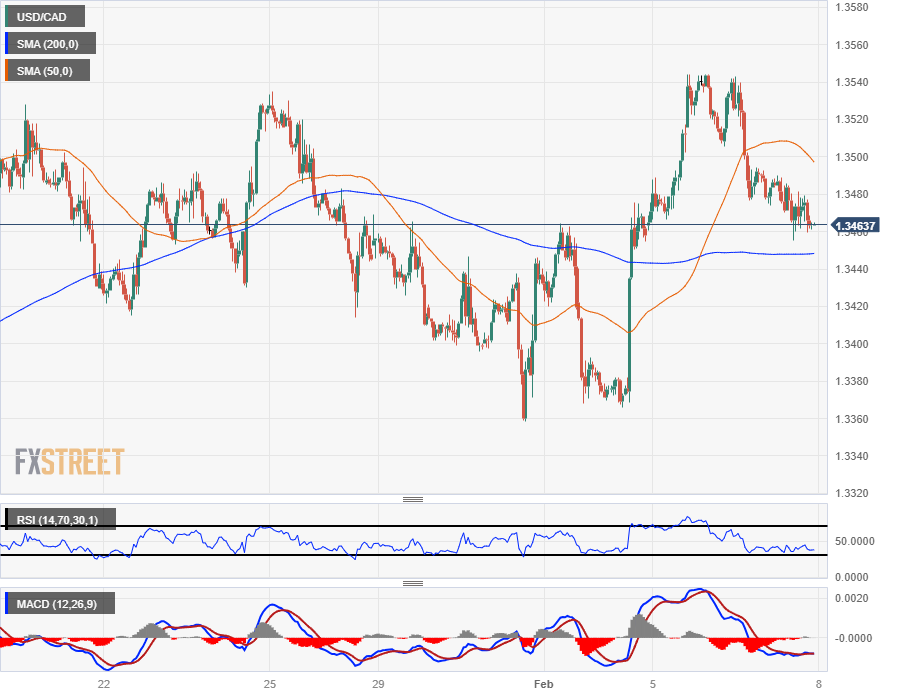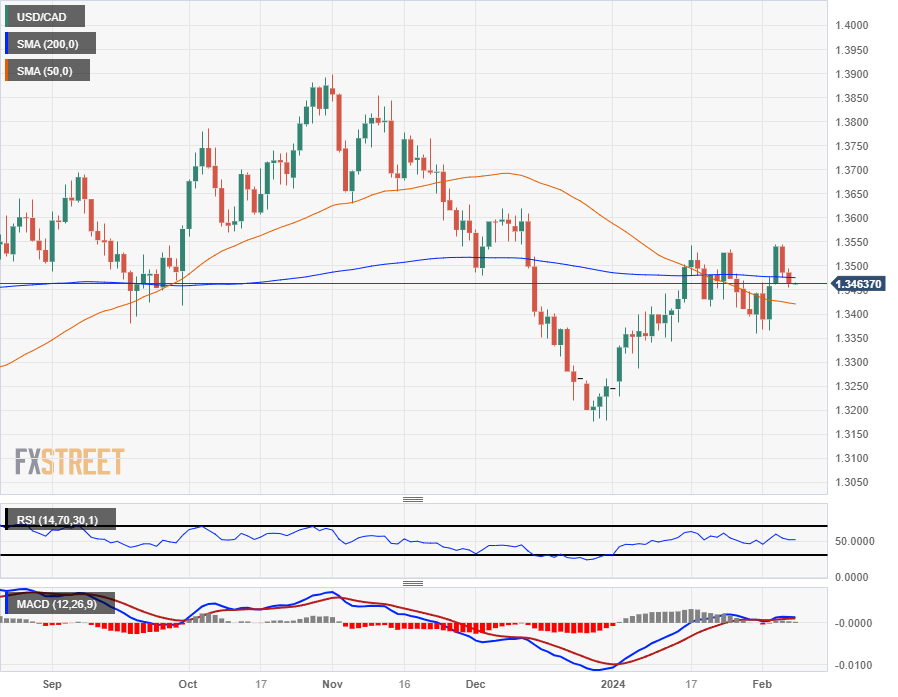Canadian Dollar shifts as Loonie traders await Canadian Unemployment figures
- Canadian Dollar found a little room but remains sedate in midweek trading.
- Canada drops Unemployment Rate, job additions figures on Friday.
- An overall thin week on the calendar leaves markets in a quiet lurch.
The Canadian Dollar (CAD) saw soft gains on Wednesday as markets steadily ate away at last week’s surge in the US Dollar (USD) that sent the Loonie skidding into multi-month lows. The Canadian Dollar is sticking close to firmly-entrenched median bids against the Greenback as broad-market momentum bleeds into the midrange.
Canada sees January’s Unemployment Rate and Net Change in Employment figures on Friday, and Loonie traders will be gearing up for the key labor data dump with markets holding steady, rounding the corner on Wednesday.
Daily digest market movers: Canadian Dollar trades thin, but eyes on the upside
- Wednesday’s key headlines focus on talking points from US Federal Reserve (Fed) policymakers with several Fed Board members hitting the newswires.
- The economic calendar remains thin midweek as investors continue to chew on rate cut prospects.
- Money markets remain far out-of-line with current Fed projections on rate cuts.
- Minneapolis Fed President Neel Kashkari reiterated his view of two or three rate cuts through 2024.
- The CME’s FedWatch Tool shows money markets are still pricing in at least six rate cuts this year, though cracks are beginning to show in the odds.
- Money markets now see a 66.4% chance of a rate cut in May, down significantly from being fully priced in just a month ago.
- Canada is expected to see its Unemployment Rate tick upward in January to 5.9% from 5.8%.
- Canada’s Net Change in Employment is forecast to add 15K new jobs in January.
- BoC Summary of Deliberations: Global growth has slowed, but less than projected
Canadian Dollar price today
The table below shows the percentage change of Canadian Dollar (CAD) against listed major currencies today. Canadian Dollar was the strongest against the Swiss Franc.
| USD | EUR | GBP | CAD | AUD | JPY | NZD | CHF | |
| USD | -0.15% | -0.18% | -0.20% | 0.12% | 0.21% | -0.23% | 0.54% | |
| EUR | 0.13% | -0.03% | -0.05% | 0.27% | 0.36% | -0.08% | 0.68% | |
| GBP | 0.18% | 0.02% | -0.03% | 0.30% | 0.39% | -0.05% | 0.73% | |
| CAD | 0.20% | 0.05% | -0.01% | 0.27% | 0.40% | -0.04% | 0.69% | |
| AUD | -0.11% | -0.28% | -0.31% | -0.32% | 0.12% | -0.37% | 0.42% | |
| JPY | -0.21% | -0.35% | -0.37% | -0.41% | -0.08% | -0.42% | 0.30% | |
| NZD | 0.23% | 0.08% | 0.06% | 0.03% | 0.35% | 0.44% | 0.77% | |
| CHF | -0.58% | -0.69% | -0.76% | -0.74% | -0.39% | -0.31% | -0.77% |
The heat map shows percentage changes of major currencies against each other. The base currency is picked from the left column, while the quote currency is picked from the top row. For example, if you pick the Euro from the left column and move along the horizontal line to the Japanese Yen, the percentage change displayed in the box will represent EUR (base)/JPY (quote).
Technical analysis: Canadian Dollar broadly higher, but action remains thin
The Canadian Dollar (CAD) saw gains against nearly all of its major currency peers on Wednesday, gaining notable ground against the Swiss Franc (CHF) and the Japanese Yen (JPY). The Canadian Dollar is close to flat against the Pound Sterling (GBP) and the New Zealand Dollar (NZD), while the Loonie is up around a fifth of a percent against the US Dollar, helping to keep the USD/CAD pair pinned below the 1.3500 handle.
USD/CAD fell below 1.3500 on Tuesday, and the pair remains unable to reclaim the key handle, etching in an intraday low of 1.3455 on Wednesday.
Daily candlesticks have the USD/CAD trading firmly into the 200-day Simple Moving Average (SMA) near 1.3475, and the pair is at risk of tipping back into a congestion zone between the 50-day and 200-day SMAs as long-term trends drift into a consolidation trap.
A tilt into bullish territory will need to break above 1.3550 to make another leg higher, while sellers will be looking for further downside from the near-term swing low into 1.3558.
USD/CAD hourly chart
USD/CAD daily chart
Canadian Dollar FAQs
What key factors drive the Canadian Dollar?
The key factors driving the Canadian Dollar (CAD) are the level of interest rates set by the Bank of Canada (BoC), the price of Oil, Canada’s largest export, the health of its economy, inflation and the Trade Balance, which is the difference between the value of Canada’s exports versus its imports. Other factors include market sentiment – whether investors are taking on more risky assets (risk-on) or seeking safe-havens (risk-off) – with risk-on being CAD-positive. As its largest trading partner, the health of the US economy is also a key factor influencing the Canadian Dollar.
How do the decisions of the Bank of Canada impact the Canadian Dollar?
The Bank of Canada (BoC) has a significant influence on the Canadian Dollar by setting the level of interest rates that banks can lend to one another. This influences the level of interest rates for everyone. The main goal of the BoC is to maintain inflation at 1-3% by adjusting interest rates up or down. Relatively higher interest rates tend to be positive for the CAD. The Bank of Canada can also use quantitative easing and tightening to influence credit conditions, with the former CAD-negative and the latter CAD-positive.
How does the price of Oil impact the Canadian Dollar?
The price of Oil is a key factor impacting the value of the Canadian Dollar. Petroleum is Canada’s biggest export, so Oil price tends to have an immediate impact on the CAD value. Generally, if Oil price rises CAD also goes up, as aggregate demand for the currency increases. The opposite is the case if the price of Oil falls. Higher Oil prices also tend to result in a greater likelihood of a positive Trade Balance, which is also supportive of the CAD.
How does inflation data impact the value of the Canadian Dollar?
While inflation had always traditionally been thought of as a negative factor for a currency since it lowers the value of money, the opposite has actually been the case in modern times with the relaxation of cross-border capital controls. Higher inflation tends to lead central banks to put up interest rates which attracts more capital inflows from global investors seeking a lucrative place to keep their money. This increases demand for the local currency, which in Canada’s case is the Canadian Dollar.
How does economic data influence the value of the Canadian Dollar?
Macroeconomic data releases gauge the health of the economy and can have an impact on the Canadian Dollar. Indicators such as GDP, Manufacturing and Services PMIs, employment, and consumer sentiment surveys can all influence the direction of the CAD. A strong economy is good for the Canadian Dollar. Not only does it attract more foreign investment but it may encourage the Bank of Canada to put up interest rates, leading to a stronger currency. If economic data is weak, however, the CAD is likely to fall.